
How did the Earth Get Here?

How did the Earth Get Here?
Clues to the Formation of the Solar System:
The question then becomes, did planets form by just "appearing" whole
out of the initial solar nebula (a mixture of gas, ice and dust
in orbit about the sun) or did the planets get "assembled".
Overwhelming evidence exists for the assembly model:
Formation of the Earth by accretion
Stars form from a giant molecular cloud (nebula) that collapses from self gravity. Actually,
several stars form from one cloud but we will only focus on one star and its planetary disk.
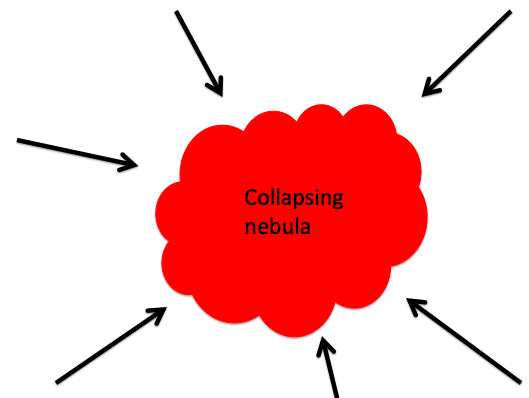
Initial solar nebula consists of mixtures of grains (rock) and ices.
The initial ratio is about 90% ices and 10% grains
The sun is generating energy and acts as a heating source to this
nebula. 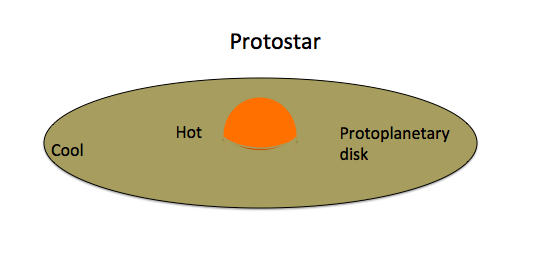
Material closer to the sun is substanially hotter than
material far from the sun  so there is a temperature gradient in this mixture. This is schematically shown below with
the positions of Venus (V), Earth (E), Mars (M) and Jupiter (J) shown
along with the approximate temperature that material would be at
those distances.
so there is a temperature gradient in this mixture. This is schematically shown below with
the positions of Venus (V), Earth (E), Mars (M) and Jupiter (J) shown
along with the approximate temperature that material would be at
those distances.
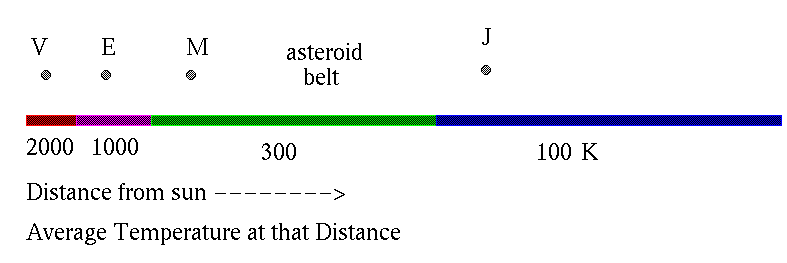
In the inner part of the solar system, only things which exist as a solid at high temperature are available to be used as raw materials for planetary assembly (so how come there is so much water on the earth? -- answer later)
In the inner part of the solar system you can only make a
rocky planet via acretion of grains.
In the outer part of the solar system, ices can exist so you can
make larger planets (e.g. Uranus and Neptune) out of the much
more abundant ices. Ice is sticky, and gathers much more easily than rock. Thus
these planets build rather quickly
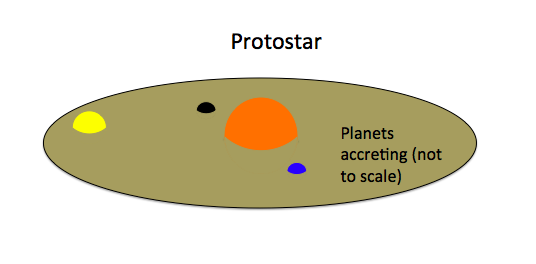
Very large planets like Jupiter and Saturn, whose composition is primarily Hydrogen and Helum, formed in a manner similar to the Sun, that is not by accretion of building blocks but rather collapsed due to self gravity. Note that Jupiter can never become a star. A star is a ball of gas sufficiently hot to excite nuclear reactions . The minimum mass require for this is about 8% the mass of the Sun. Jupiter's mass is an order of magnitude below this limit. Jupiter will never be a star.
Jupiter has a very large mass and perturbs orbits of objects near the planet. There were lots of these objects scattered between Jupiter and Pluto Jupiter redirected some of this cometary material into the inner solar system and most of the earth's water was delivered through comet bombardment (therefore would we be here without Jupiter?)
Steps in the accretion process from small grains to large planet are represented in the following sequences:
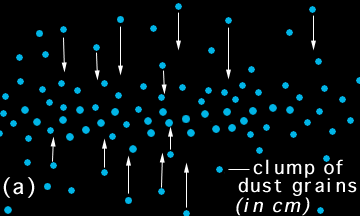 | Step 1: accretion of cm sized particles. countless numbers of these small particles collide at low relatively velocity and coalesce into objects which are a few km in diameter |
 | Step 2: Physical Collision on km scale. once these km size objects are formed, they start to smack into one another and stick thus creating fewer new objects of size 10-100 km |
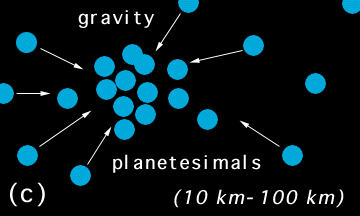 | Step 3: Gravitational accretion on 10-100 km scale. Once an object gets to a radius of 10-100 km, its cross section is larger than its physical cross section because it exerts a gravitational influence on surrounding smaller bodies and, in essence, sweeps them up. This process will create a planet with significant gaps between each swept up zone. |
 | Step 4: Molten protoplanet from the heat of accretion . For each protoplanet that forms, there are thousands of left over planetisimal objects. These planetisimals are then accelerated by the relatively large mass of the formed planets and they start to move at high velocity throughout the inner solar system - many of them ultimately impact the surfaces of the cooling planets. |
Final step is differentiation of the molten proto-planet (like earth:) Light objects float; heavy objects sink. The result is a planet with a Iron-Nickel Core (which can generate a magnetic field) and an oxygen-silicon crust.
In the outer part of the solar system, the same 4 step process of accretion occurred but it was accretion of ices (cometesimals) instead of grains.
Things to note about the formation of planets via accretion

Some of this material was ejected into a large "Comet Cloud" which has a distance of about 100,000 AU from the Sun and some of the leftover debris ( beyond Pluto) could not be ejected (as it was far away from Uranus and Neptune) and hence remained there. This material is known as the Kuiper Belt and it was recently discovered by the Hubble Space Telescope
More information on the Kuiper belt and the kinds of objects that are located there can be found here
There are alternative theories to planetary formation particularly now as astronomers discover planetary systems that seemingly conflict with our understanding of how planets form.